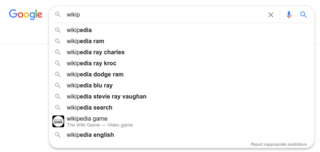Information retrieval (IR) in computing and information science is the task of identifying and retrieving information system resources that are relevant to an information need. The information need can be specified in the form of a search query. In the case of document retrieval, queries can be based on full-text or other content-based indexing. Information retrieval is the science of searching for information in a document, searching for documents themselves, and also searching for the metadata that describes data, and for databases of texts, images or sounds.

Memex is a hypothetical electromechanical device for interacting with microform documents and described in Vannevar Bush's 1945 article "As We May Think". Bush envisioned the memex as a device in which individuals would compress and store all of their books, records, and communications, "mechanized so that it may be consulted with exceeding speed and flexibility". The individual was supposed to use the memex as an automatic personal filing system, making the memex "an enlarged intimate supplement to his memory". The name memex is a portmanteau of memory and expansion.

A Web crawler, sometimes called a spider or spiderbot and often shortened to crawler, is an Internet bot that systematically browses the World Wide Web and that is typically operated by search engines for the purpose of Web indexing.
Spamdexing is the deliberate manipulation of search engine indexes. It involves a number of methods, such as link building and repeating unrelated phrases, to manipulate the relevance or prominence of resources indexed in a manner inconsistent with the purpose of the indexing system.
Search engine optimization (SEO) is the process of improving the quality and quantity of website traffic to a website or a web page from search engines. SEO targets unpaid traffic rather than direct traffic or paid traffic. Unpaid traffic may originate from different kinds of searches, including image search, video search, academic search, news search, and industry-specific vertical search engines.

Googlebot is the web crawler software used by Google that collects documents from the web to build a searchable index for the Google Search engine. This name is actually used to refer to two different types of web crawlers: a desktop crawler and a mobile crawler.
The deep web, invisible web, or hidden web are parts of the World Wide Web whose contents are not indexed by standard web search-engine programs. This is in contrast to the "surface web", which is accessible to anyone using the Internet. Computer scientist Michael K. Bergman is credited with inventing the term in 2001 as a search-indexing term.

A metasearch engine is an online information retrieval tool that uses the data of a web search engine to produce its own results. Metasearch engines take input from a user and immediately query search engines for results. Sufficient data is gathered, ranked, and presented to the users.
Document retrieval is defined as the matching of some stated user query against a set of free-text records. These records could be any type of mainly unstructured text, such as newspaper articles, real estate records or paragraphs in a manual. User queries can range from multi-sentence full descriptions of an information need to a few words.
In text retrieval, full-text search refers to techniques for searching a single computer-stored document or a collection in a full-text database. Full-text search is distinguished from searches based on metadata or on parts of the original texts represented in databases.
Federated search retrieves information from a variety of sources via a search application built on top of one or more search engines. A user makes a single query request which is distributed to the search engines, databases or other query engines participating in the federation. The federated search then aggregates the results that are received from the search engines for presentation to the user. Federated search can be used to integrate disparate information resources within a single large organization ("enterprise") or for the entire web.

A search engine is a software system that provides hyperlinks to web pages and other relevant information on the Web in response to a user's query. The user inputs a query within a web browser or a mobile app, and the search results are often a list of hyperlinks, accompanied by textual summaries and images. Users also have the option of limiting the search to a specific type of results, such as images, videos, or news.
A search engine results page (SERP) is a webpage that is displayed by a search engine in response to a query by a user. The main component of a SERP is the listing of results that are returned by the search engine in response to a keyword query.
A vertical search engine is distinct from a general web search engine, in that it focuses on a specific segment of online content. They are also called specialty or topical search engines. The vertical content area may be based on topicality, media type, or genre of content. Common verticals include shopping, the automotive industry, legal information, medical information, scholarly literature, job search and travel. Examples of vertical search engines include the Library of Congress, Mocavo, Nuroa, Trulia, and Yelp.
Search engine indexing is the collecting, parsing, and storing of data to facilitate fast and accurate information retrieval. Index design incorporates interdisciplinary concepts from linguistics, cognitive psychology, mathematics, informatics, and computer science. An alternate name for the process, in the context of search engines designed to find web pages on the Internet, is web indexing.
A search appliance (SA) is a type of computer appliance which is attached to a corporate network for the purpose of indexing the content shared across that network in a way that is similar to a web search engine.
Enterprise search is the practice of making content from multiple enterprise-type sources, such as databases and intranets, searchable to a defined audience.
Ranking of query is one of the fundamental problems in information retrieval (IR), the scientific/engineering discipline behind search engines. Given a query q and a collection D of documents that match the query, the problem is to rank, that is, sort, the documents in D according to some criterion so that the "best" results appear early in the result list displayed to the user. Ranking in terms of information retrieval is an important concept in computer science and is used in many different applications such as search engine queries and recommender systems. A majority of search engines use ranking algorithms to provide users with accurate and relevant results.
DeepPeep was a search engine that aimed to crawl and index every database on the public Web. Unlike traditional search engines, which crawl existing webpages and their hyperlinks, DeepPeep aimed to allow access to the so-called Deep web, World Wide Web content only available via for instance typed queries into databases. The project started at the University of Utah and was overseen by Juliana Freire, an associate professor at the university's School of Computing WebDB group. The goal was to make 90% of all WWW content accessible, according to Freire. The project ran a beta search engine and was sponsored by the University of Utah and a $243,000 grant from the National Science Foundation. It generated worldwide interest.
The following outline is provided as an overview of and topical guide to search engines.






